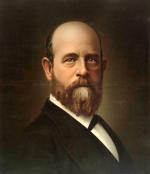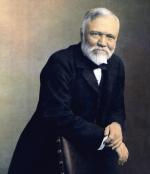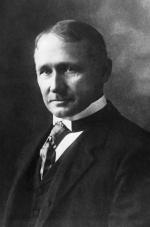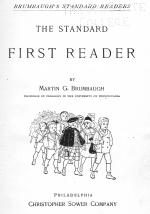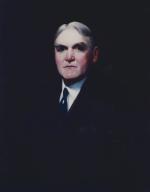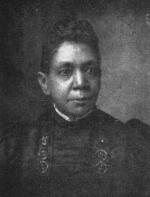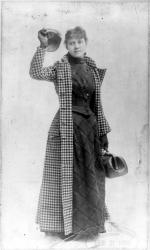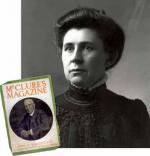Chapter Four: Making Sense of the Industrial World
In the great "Gilded Age" that followed the end of the American Civil War, Pennsylvania emerged as an economic colossus, the nation's leading producer of coal, iron, oil, steel, timber, cement, and many manufactured goods. It also became one of the nation's foremost battlegrounds in the prolonged civil war between American employers and their workers. Here, the great labor wars fought in Pennsylvania's railyards, steel mills, and coal mines also found their expression in words.
What was the best way to organize the nation's world-beating industrial economy? What principles and laws should govern the relationships between capital, labor, government, and consumers? In the late 1800s, the Pennsylvania Railroad, Carnegie Steel Company, Standard Oil, and other industrial giants were employing thousands of workers and accumulating unprecedented wealth and power- some believed predatory power- over governments as well as their own workforces.
In Progress and Poverty: An Inquiry into the Causes of Industrial Depressions and of Increase of Want with Increase of Wealth (1879), economist Henry George called for a radical restructuring of America's economic system based on "the Gospel of Christ," in which government ownership would create a society of plenty and eliminate competition for scarce resources. George's beautifully written book found devoted readers and converts around the world, including Russian novelist Leon Tolstoy.
Henry George called for a radical restructuring of America's economic system based on "the Gospel of Christ," in which government ownership would create a society of plenty and eliminate competition for scarce resources. George's beautifully written book found devoted readers and converts around the world, including Russian novelist Leon Tolstoy.
A decade later, steel baron Andrew Carnegie gave clear and compelling voice to "The Gospel of Wealth," in a deeply influential essay published by the North American in 1889, which espoused a mix of Social Darwinism and a code of conduct for captains of industries that still resonates today. In the mills of Bethlehem Steel, Philadelphia engineer
Andrew Carnegie gave clear and compelling voice to "The Gospel of Wealth," in a deeply influential essay published by the North American in 1889, which espoused a mix of Social Darwinism and a code of conduct for captains of industries that still resonates today. In the mills of Bethlehem Steel, Philadelphia engineer  Frederick Winslow Taylor conducted the time-motion studies on which he based
Frederick Winslow Taylor conducted the time-motion studies on which he based  The Principles of Scientific Management (1911), the deeply influential book that laid out the "scientific" principles of modern business organization and decision theory that would maximize both worker productivity and corporate profits.
The Principles of Scientific Management (1911), the deeply influential book that laid out the "scientific" principles of modern business organization and decision theory that would maximize both worker productivity and corporate profits.
Windows into the lives and struggles and world views of Pennsylvanians who came of age and fought for their vision of a better America during the industrial revolution are also available to us through autobiographies, including Knights of Labor president and Scranton mayor Terence Powderly,; Pennsylvania governor Samuel Pennypacker (The Autobiography of a Pennsylvanian, 1918); Socialist labor leader and state legislator
Terence Powderly,; Pennsylvania governor Samuel Pennypacker (The Autobiography of a Pennsylvanian, 1918); Socialist labor leader and state legislator  James Maurer; Senator George Wharton Pepper (Philadelphia Lawyer: An Autobiography, 1944); Philadelphia Mayor
James Maurer; Senator George Wharton Pepper (Philadelphia Lawyer: An Autobiography, 1944); Philadelphia Mayor  William Vare; and United Mine Workers of America labor organizer
William Vare; and United Mine Workers of America labor organizer  John Brophy.
John Brophy.
Pennsylvanians had long understood how the ability to read and write empowers people, enables them to achieve their American dreams, and makes them better fit for the responsibilities of citizenship. In the 1800s, Pennsylvanians played significant roles in the national movement to combat illiteracy and educate the nation's children and adults. Pennsylvania's landmark Free Schools Act of 1834 provided public education for poor children across the Commonealth.
In the decades that followed, generations of schoolchildren across the nation learned reading, writing, and arithmetic using a reader written by Pennsylvania-born and -educated William Holmes McGuffy. In the 1890s, many schools replaced their old McGuffey Readers with a new reader written by Juniata College president
William Holmes McGuffy. In the 1890s, many schools replaced their old McGuffey Readers with a new reader written by Juniata College president  Martin Brumbaugh In 1914, Brumbaugh, a Pennsylvania-German pacifist, became the only Ph.D. elected governor of Pennsylvania.
Martin Brumbaugh In 1914, Brumbaugh, a Pennsylvania-German pacifist, became the only Ph.D. elected governor of Pennsylvania.
Founded by Thomas Foster in Scranton in 1891, the International Correspondence Schools became the nation's largest provider of mail-order curriculum for miners and other blue-collar workers eager to improve their lives. African-Americans, too, understood the power and importance of the written word. Notable among them,
Thomas Foster in Scranton in 1891, the International Correspondence Schools became the nation's largest provider of mail-order curriculum for miners and other blue-collar workers eager to improve their lives. African-Americans, too, understood the power and importance of the written word. Notable among them,  Fanny M. Jackson Coppin, the beloved principal of Philadelphia's Institute for Colored Youth from 1869 to 1902, shared her educational experiences and philosophy in Reminiscences of School Life, and Hints on Teaching, published by the Philadelphia-based A.M.E. Book Concern in 1913.
Fanny M. Jackson Coppin, the beloved principal of Philadelphia's Institute for Colored Youth from 1869 to 1902, shared her educational experiences and philosophy in Reminiscences of School Life, and Hints on Teaching, published by the Philadelphia-based A.M.E. Book Concern in 1913.
Rotary presses, cheap wood pulp paper, typesetting machines, new processes for the printing of photographs and color, and other technological innovations fueled a publishing revolution in the 1800s and the great age of American newspaper and magazine publishing. In the early 1900s, Philadelphia boasted thirteen daily newspapers, including the Philadelphia Tribune. Founded in 1884, the Tribune today is the longest-running African-American newspaper in the United States. In Pittsburgh, the Pittsburgh Courier, under the leadership of editor Robert Vann became the country's most widely circulated African-American newspaper.
Robert Vann became the country's most widely circulated African-American newspaper.
To attract readers and advertisers, American newspapers introduced sports and magazine sections, expansive coverage of local events, investigative journalism, and sensationalism. The newspaper revolution created unprecedented opportunities for journalists, including a new generation of female reporters. In 1899, Pittsburgh's Nellie Bly thrilled the readers of the New York World with accounts of her seventy-two-day trip around the world-the fastest time to that date.
Nellie Bly thrilled the readers of the New York World with accounts of her seventy-two-day trip around the world-the fastest time to that date.
 Ida Tarbell's investigative history of John D. Rockefeller's powerful Standard Oil Company, which acquired most of its wealth from the oil fields of western Pennsylvania, published by McClure's in nineteen installments between 1902 and 1904, caused such outrage that the federal government prosecuted Standard Oil as an "unreasonable" monopoly and forced it to break into thirty-four independent companies.
Ida Tarbell's investigative history of John D. Rockefeller's powerful Standard Oil Company, which acquired most of its wealth from the oil fields of western Pennsylvania, published by McClure's in nineteen installments between 1902 and 1904, caused such outrage that the federal government prosecuted Standard Oil as an "unreasonable" monopoly and forced it to break into thirty-four independent companies.
In 1903, McClure's also published Lincoln Steffens's devastating exposés of the political corruption of Philadelphia and
Philadelphia and  Pittsburgh. Later exposés of corruption, including J.T. Salter's fascinating glimpses into Philadelphia ward-level politics (Boss Rule: Portraits in City Politics, 1935), would continue through the twentieth century to the present day.
Pittsburgh. Later exposés of corruption, including J.T. Salter's fascinating glimpses into Philadelphia ward-level politics (Boss Rule: Portraits in City Politics, 1935), would continue through the twentieth century to the present day.
At the turn of the century, some of the most important and influential investigations of the nation's industrial workplaces and the living conditions of its working poor also took place in Pennsylvania. Employed by the University of Pennsylvania to conduct an examination of the lives of African Americans in Philadelphia's Seventh Ward, W.E.B. Du Bois published The Philadelphia Negro, his groundbreaking sociological study in 1899. Across the state in Pittsburgh, a team of researchers funded by the Russell Sage Foundation in the early 1900s undertook the
W.E.B. Du Bois published The Philadelphia Negro, his groundbreaking sociological study in 1899. Across the state in Pittsburgh, a team of researchers funded by the Russell Sage Foundation in the early 1900s undertook the  Pittsburgh Survey, one of the most comprehensive and startling studies of the work lives and living conditions of American immigrants and the working poor.
Pittsburgh Survey, one of the most comprehensive and startling studies of the work lives and living conditions of American immigrants and the working poor.
The investigations, published in a series of studies and in newspapers and magazines nationwide, played an important role in the passage of workmen's compensation laws and other reforms in states across the nation. More studies followed, including R.R. Wright Jr.'s The Negro in Pennsylvania: An Economic History (1908) and Sadie Alexander's study of 100 African-American families who had moved to Philadelphia from the American South during the Great Migration unleashed by the First World War.
Sadie Alexander's study of 100 African-American families who had moved to Philadelphia from the American South during the Great Migration unleashed by the First World War.
What was the best way to organize the nation's world-beating industrial economy? What principles and laws should govern the relationships between capital, labor, government, and consumers? In the late 1800s, the Pennsylvania Railroad, Carnegie Steel Company, Standard Oil, and other industrial giants were employing thousands of workers and accumulating unprecedented wealth and power- some believed predatory power- over governments as well as their own workforces.
In Progress and Poverty: An Inquiry into the Causes of Industrial Depressions and of Increase of Want with Increase of Wealth (1879), economist
A decade later, steel baron
Windows into the lives and struggles and world views of Pennsylvanians who came of age and fought for their vision of a better America during the industrial revolution are also available to us through autobiographies, including Knights of Labor president and Scranton mayor
Pennsylvanians had long understood how the ability to read and write empowers people, enables them to achieve their American dreams, and makes them better fit for the responsibilities of citizenship. In the 1800s, Pennsylvanians played significant roles in the national movement to combat illiteracy and educate the nation's children and adults. Pennsylvania's landmark Free Schools Act of 1834 provided public education for poor children across the Commonealth.
In the decades that followed, generations of schoolchildren across the nation learned reading, writing, and arithmetic using a reader written by Pennsylvania-born and -educated
Founded by
Rotary presses, cheap wood pulp paper, typesetting machines, new processes for the printing of photographs and color, and other technological innovations fueled a publishing revolution in the 1800s and the great age of American newspaper and magazine publishing. In the early 1900s, Philadelphia boasted thirteen daily newspapers, including the Philadelphia Tribune. Founded in 1884, the Tribune today is the longest-running African-American newspaper in the United States. In Pittsburgh, the Pittsburgh Courier, under the leadership of editor
To attract readers and advertisers, American newspapers introduced sports and magazine sections, expansive coverage of local events, investigative journalism, and sensationalism. The newspaper revolution created unprecedented opportunities for journalists, including a new generation of female reporters. In 1899, Pittsburgh's
In 1903, McClure's also published Lincoln Steffens's devastating exposés of the political corruption of
At the turn of the century, some of the most important and influential investigations of the nation's industrial workplaces and the living conditions of its working poor also took place in Pennsylvania. Employed by the University of Pennsylvania to conduct an examination of the lives of African Americans in Philadelphia's Seventh Ward,
The investigations, published in a series of studies and in newspapers and magazines nationwide, played an important role in the passage of workmen's compensation laws and other reforms in states across the nation. More studies followed, including R.R. Wright Jr.'s The Negro in Pennsylvania: An Economic History (1908) and





